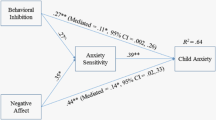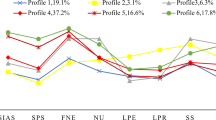Abstract
Although several theoretical models posit that low levels of anxiety are a risk factor for psychopathy and antisocial behavior, a number of studies have reported elevated levels of anxiety among antisocial individuals. Nevertheless, most investigators in this literature have not distinguished between fearfulness and trait anxiety or attempted to separate the antisocial lifestyle dimension from the callous and unemotional dimension of psychopathy. In a study of clinically referred children (N = 143), we found that (a) measures of trait anxiety and fearlessness (low fearfulness) exhibited low correlations; (b) conduct problems tended to be positively correlated with trait anxiety, whereas callous and unemotional traits tended to be negatively correlated with trait anxiety; and (c) controlling statistically for the effects of one dimension increased the divergent correlations of the other dimension with both trait anxiety and fearful inhibition. These findings bear potentially important implications for the diagnosis and etiology of psychopathy and antisocial behavior and suggest that distinctions between trait anxiety and fearful inhibition, as well as between the two dimensions of psychopathy, may help to clarify longstanding confusion in this literature.
Similar content being viewed by others
REFERENCES
Achenbach, T. M. (1991). The Child Behavior Checklist-1991. Burlington: University of Vermont.
American Psychiatric Association. (1987). The diagnostic and statistical manual of mental disorders (3rd ed., rev). Washington, DC: Author.
American Psychiatric Association. (1994). The diagnostic and statistical manual of mental disorders (4th ed). Washington, DC; Author.
Blackburn, R. (1998). Psychopathy and personality disorder: Implications of interpersonal theory. In D. J. Cooke, A. E. Forth, & R. D. Hare (Eds.), Psychopathy: Theory, research, and implications for society (pp. 269–302). Dordrecht, The Netherlands: Kluwer.
Boyd, J. H., Burke, J. D., Greenberg, E., Holzer, C. E., Rae, D. S., George, L. K., Karno, M., Stolzman, R., McEvoy, L., & Nesdadt. G. (1984). Exclusion criteria of DSM-III: A study of the co-occurrence of hierarchy-free syndromes. Archives of General Psychiatry, 41, 983–989.
Butcher, J. N., Graham, J. R., Williams, C. R., & Ben-Porath, Y.S. (1990). Development and use of the MMPI-2 content scales. Minneapolis: University of Minnesota Press.
Christian, R., Frick, P.J., Hill, N., Tyler, L. A., & Frazer, D. (1997). Psychopathy and conduct problems in children: II. Subtyping children with conduct problems based on their interpersonal and affective style. Journal of the American Academy of Child and Adolescent Psychiatry, 36, 233–241.
Cleckley, H. (1982). The mask of sanity. St. Louis, MO: Mosby. (Original work published 1941)
Cloninger, C. R. (1987). A systematic method for clinical description and classification of personality variants. Archives of General Psychiatry, 44, 573–588.
Cohen, J., & Cohen, P. (1983). Applied multiple regression for the behavioral sciences (2nd ed.). Hillsdale, NJ: Erlbaum.
Depue, R. A., & Spoont, M. R. (1987). Conceptualizing a serotonin trait: A dimension of behavioral constraint. InJ. Mann & M. Stanley (Eds.), The psychobiology of suicidal behavior (pp. 47–62). New York: New York Academy of Sciences.
Dien, J. (1999). Differential lateralization of trait anxiety and fearfulness: Evoked potential correlates. Personality and Individual Differences, 26, 333–356.
Duckworth, J. C., & Anderson, W. P. (1995). MMPI and MMPI-2 interpretation manual for counselors and clinicians. Bristol, PA: Accelerated Development.
Fergusson, D. M., & Horwood, L. J. (1993). The structure, stability, and correlations of the trait components of conduct disorder, attention deficit, and anxiety/withdrawal reports. Journal of Child Psychology and Psychiatry, 34, 749–766.
Fowles, D. C. (1987). Application of a behavioral theory of motivation to the concepts of anxiety and impulsivity. Journal of Research in Personality, 21, 417–435.
Fowles, D. C. (1988). Psychophysiology and psychopathology: A motivational approach. Psychophysiology, 25, 373–391.
Frankenhauser, M. (1978). Psychoneuroendocrine approaches to the study of emotion as related to stress and coping. In R. A. Dienstbier (Ed.), Nebraska symposium on motivation (Vol. 26, pp. 123–161). Lincoln: University of Nebraska Press.
Frick, P. J. (1998). Callous-unemotional traits and conduct problems: A two-factor model of psychopathy in children. In R. D. Hare, D. J. Cooke, & A. Forth (Eds.), Psychopathy: Theory, research, and implications for society (pp. 161–187). Dordrecht, The Netherlands: Kluwer.
Frick, P. J., & Hare, R. D. (in press). The Psychopathy Screening Device. Toronto, Ontario, Canada: Multi-Health Systems.
Frick, P. J., O'Brien, B. S., Wootton, I. M., & McBurnett, K. (1994). Psychopathy and conduct problems in children. Journal of Abnormal Psychology, 103, 700–707.
Gray, J. A. (1982). The neuropsychology of anxiety: An enquiry into the functions of the septo-hippocampal system. Oxford, England: Oxford University Press.
Hare, R. D. (1991). The Psychopathy Checklist—Revised. Toronto, Ontario, Canada: Multi-Health Systems.
Hare, R. D., Hart, S. D., & Harpur, T. J. (1991). Psychopathy and the DSM-IV criteria for antisocial personality disorder. Journal of Abnormal Psychology, 100, 391–398.
Harpur, T. J., Hare, R. D., & Hakstian, A. R. (1989). Two-factor conceptualization of psychopathy. Construct validity and assessment implications. Psychological Assessment, 1, 6–17.
Hauser, R. M., & Featherman, D. L. (1977). The process of stratification. New York: Academic Press.
Hodges, K., & Zeman, J. (1993). Interviewing. In T. H. Ollendick & M. Hersen (Eds.), Handbook of child and adolescent assessment (pp. 65–81). Boston: Allyn & Bacon.
Kamphaus, R. W., & Frick, P. J. (1996). The clinical assessment of children's emotion, behavior, and personality. Boston: Allyn & Bacon.
Krueger, R. F., Schmutte, P. S., Caspi, A., Moffitt, T. E., Campbell, K., & Silva, P. A. (1994). Personality traits are linked to crime among men and women: Evidence from a birth cohort. Journal of Abnormal Psychology, 103, 328–338.
Lahey, B. B., Applegate, B., Barkley, R. A., Carfinkel, B., McBurnett, K., Kerdyck, L., Greenhill, L., Hynd, G. W., Frick, P. J., Newcorn, J., Biederman, J., Ollendick, T., Hart, E. L., Perez, D., Waldman, I., & Shaffer, D. (1994). DSM-IV field trials for oppositional defiant disorder and conduct disorder in children and adolescents. American Journal of Psychiatry, 151, 1163–1171.
Levenson, M. R., Kiehl, K. A., & Fitzpatrick, C. M. (1995). Assessing psychopathic attributes in a noninstitutionalized population. Journal of Personality and Social Psychology, 68, 151–158.
Lilienfeld, S. O. (1994). Conceptual problems in the assessment of psychopathy. Clinical Psychology Review, 14, 17–38.
Lilienfeld, S. O., & Andrews, B. P. (1996). Development and preliminary validation of a self-report measure of psychopathic personality traits in noncriminal populations. Journal of Personality Assessment, 66, 488–524.
Lykken, D. T. (1968). Statistical significance in psychological research. Psychological Bulletin, 70, 151–159.
Lykken, D. T. (1982, Jan.). Fearlessness: Its carefree charm and deadly risks. Psychology Today, 16, 20–28.
Lykken, D. T. (1995). The antisocial personalities. Hillsdale, NJ: Erlbaum.
McBurnett, K., Lahey, B. B., Frick, P. J., Risch, C., Loeber, R., Hart, E. L., Christ, M. A. G., & Hanson, K. S. (1991). Anxiety, inhibition, and conduct disorder in children: II. Relation to salivary control. Journal of the American Academy of Child and Adolescent Psychiatry, 30, 192–196.
McHoskey, J. W., Worzel, W., & Szyarto, C. (1998). Machiavellianism and psychopathy. Journal of Personality and Social Psychology, 74, 192–210.
Newman, J. P., Patterson, C. M., & Kosson, D. S. (1987). Response perseveration in psychopaths. Journal of Abnormal Psychology, 96, 145–148.
Newman, J. P., & Wallace, J. F. (1993). Diverse pathways to deficient self-regulation: Implications for disinhibitory psychopathology in children. Clinical Psychology Review, 13, 699–720.
Newman, J. P., Widom, C. S., & Nathan, S. (1985). Passiveavoidance in syndromes of disinhibition: Psychopathy and extraversion. Journal of Personality and Social Psychology, 48, 1316–1327.
O'Brien, B. S., & Frick, P. J. (1996). Reward dominance: Associations with anxiety, conduct problems, and psychopathy in children. Journal of Abnormal Child Psychology, 24, 223–240.
O'Brien, B. S., Frick, P. J., & Lyman, R. D. (1994). Reward dominance among children with disruptive behavior disorders. Journal of Psychopathology and Behavioral Assessment, 16, 131–145.
Patrick, C. J. (1994). Emotion and psychopathy: Startling new insights. Psychophysiology, 31, 319–330.
Patrick, C. J., Bradley, M. M., & Lang, P. J. (1993). Emotion in the criminal psychopath: Startle reflex modulation. Journal of Abnormal Psychology, 102, 82–92.
Piacentini, J. C., Cohen, P., & Cohen, J. (1992). Combining discrepant diagnostic information from multiple sources: Are complex algorithms better than simple ones? Journal of Abnormal Child Psychology, 20, 51–63.
Quay, H. C. (1987). Patterns of delinquent behavior. In H. C. Quay (Ed.), Handbook of juvenile delinquency (pp. 118–138). New York: Wiley.
Robins, L. N., Tipp, J., & Pryzbeck, T. (1991). Antisocial personality. In L. N. Robins & D. A. Regier (Eds.), Psychiatric disorders in North America (pp. 258–290). New York: Free Press.
Rosen, J. B., & Schulkin, J. (1998). From normal fear to pathological anxiety. Psychological Review, 105, 325–350.
Russo, M. F., & Beidel, D. C. (1993). Co-morbidity of childhood anxiety and externalizing disorders: Prevalence, associated characteristics, and validation issues. Clinical Psychology Review, 14, 199–221.
Russo, M. F., Lahey, B. B., Christ, M. A. G., Frick, P. J., McBurnett, K., Walker, J. L., Loeber, R., Stouthamer-Loeber, M., & Green, S. M. (1991). Preliminary development of a sensation seeking scale for children. Personality and Individual Differences, 12, 399–405.
Russo, M. F., Stokes, G. S., Lahey, B. B., Christ, M. A. G., McBurnett, K., Loeber, R., Stouthamer-Loeber, M., & Green, S. M. (1993). A sensation-seeking scale for children: A further refinement and psychometric development. Journal of Psychopathology and Behavioral Assessment, 15, 69–86.
Shaffer, D., Fisher, P., Piacentini, J. C., Schwab-Stone, M., & Wicks, J. (1992). National Institute of Mental Health Diagnostic Interview Schedule for Children, Version 2.3. New York: Columbia University Press.
Tellegen, A. (1982). Manual for the Multidimensional Personality Questionnaire. Unpublished manuscript, University of Minnesota.
Tellegen, A., & Waller, N. G. (1994). Exploring personality through test construction: Development of the Multidimensional Personality Questionnaire. In S. R. Briggs & J. M. Cheek (Eds.), Personality measures: Development and evaluation (Vol. 1, pp. 133–161). Greenwich, CT: JAI Press.
Walker, J. L., Lahey, B. B., Russo, M. F., Frick, P. J., Christ, M. A. G., McBurnett, K., Loeber, R., Stouthamer-Loeber, M., & Green, S. M. (1991). Anxiety, inhibition, and conduct disorder in children: I. Relations to social impairment. Journal of the American Academy of Child and Adolescent Psychiatry, 30, 187–191.
Wallbank, J. (1985). Antisocial and prosocial behavior among contemporary Robin Hoods. Personality and Individual Differences, 6, 11–19.
Watson, D., & Clark, L. A. (1984). Negative affectivity: The disposition to experience aversive emotional states. Psychological Bulletin, 98, 219–235.
Wechsler, D. (1974). Manual for the Wechsler Intelligence Scale for Children—Revised (WISC-R). New York: Psychological Corporation.
Wechsler, D. (1991). Manual for the Wechsler Intelligence Scale for Children—3rd edition (WISC-III). New York: Psychological Corporation.
Zoccolillo, M. (1992). Co-occurrence of conduct disorder and its adult outcomes with depressive and anxiety disorders: A review. Journal of the American Academy of Child and Adolescent Psychiatry, 31, 547–556.
Zuckerman, M. (1994). Behavioral expressions and biosocial bases of sensation seeking. New York: Cambridge University Press.
Zuckerman, M., Kolin, E. A., Price, L., & Zoob, I. (1964). Development of a sensation seeking scale. Journal of Consulting and Clinical Psychology, 28, 477–482.
Author information
Authors and Affiliations
Corresponding author
Rights and permissions
About this article
Cite this article
Frick, P.J., Lilienfeld, S.O., Ellis, M. et al. The Association between Anxiety and Psychopathy Dimensions in Children. J Abnorm Child Psychol 27, 383–392 (1999). https://doi.org/10.1023/A:1021928018403
Issue Date:
DOI: https://doi.org/10.1023/A:1021928018403




